Key Takeaways
- Dog hair is made of keratin, the same protein found in human hair and fingernails.
- Each strand of dog hair reflects your dog's health and genetic background.
- Dog hair changes with seasonal cycles, indicating natural shedding patterns.
- Understanding dog hair helps pet parents better care for their pup's coat and overall health.
Table of Contents
- Dog Hair 101: What It Is, Why It Matters, and the Science Behind Your Pup's Coat
- Decoding Your Dog's Coat Type: Why It Matters For Grooming & Shedding
- Real-World Ways to Manage Dog Hair at Home
- Grooming for Health: Keep Your Dog's Coat Shiny and Tangle-Free
- Natural, Holistic Support for a Healthy Coat
- Choosing the Right Approach for Your Dog's Coat Care
- Future Considerations for Optimal Coat Health
Dog Hair 101: What It Is, Why It Matters, and the Science Behind Your Pup's Coat
Every time you spot another dog hair on your favorite sweater, you're looking at pure keratin, the same protein that makes up human hair and fingernails. But here's what most pet parents don't realize: that single strand tells a story about your pup's health, genetics, and seasonal cycles.
In addition to regular grooming, many pet parents turn to natural relief products to help support their dog's coat and minimize excessive shedding.
Dog hair and dog fur are made of identical keratin fibers, but pet care professionals use the terms differently. "Hair" typically describes individual strands, like that stubborn one clinging to your couch cushion. "Fur" refers to the entire coat system, especially the thick, plush coverage on double-coated breeds like Golden Retrievers or Huskies.
For those looking to further enhance their dog's coat health, exploring the best selling products for natural support can be a great addition to your routine.
In everyday conversation, both terms work interchangeably. Whether you're dealing with one rogue dog hair or managing seasonal shedding, you're talking about the same keratin structures that protect and insulate your furry family member.
Layers of a Dog's Coat: Undercoat vs. Guard Hairs
Your dog's coat operates like a sophisticated climate control system with two distinct layers. The undercoat acts as thermal insulation, soft, fluffy fibers close to the skin that shed seasonally and regulate body temperature year-round. Guard hairs form the protective outer layer: longer, stiffer strands that repel water, dirt, and UV rays.
Not all dogs have both layers. Single-coated breeds like Poodles possess only guard hairs, which explains their lower shedding patterns. Double-coated champions like Border Collies and Labs shed their undercoat dramatically during spring and fall "blowouts."
How Genetics Shape Your Dog's Hair
Your pup's coat characteristics, length, texture, density, and shedding patterns, are encoded in their DNA. Evolution equipped cold-climate breeds with dense double coats for survival, while desert-dwelling ancestors developed sparse, heat-dissipating coverage. This genetic blueprint determines whether you'll find dog hairs everywhere or enjoy relatively clean furniture.
Decoding Your Dog's Coat Type: Why It Matters For Grooming & Shedding

Understanding your dog's specific coat type transforms grooming from guesswork into targeted care. The wrong brush or bathing schedule can actually increase shedding and create skin problems.
For more insights into how your dog's overall health can impact their coat, you might find our article on dog red eyes helpful, as it explores common health issues that can affect your pup's appearance and comfort.
Main Types of Dog Hair & What They Mean
Length variations don't predict shedding intensity, short-coated Beagles often shed as much as long-haired Collies. Texture differences require unique approaches: smooth coats (sleek, close to body) resist matting but shed consistently; wiry coats (Terrier-style) repel dirt but tangle easily; curly coats (Poodle-type) shed minimally but mat without regular brushing.
The single versus double coat distinction matters most for maintenance. Single coats shed steadily year-round, while double coats "blow out" seasonally, creating those tumbleweeds of dog hair that appear overnight during spring and fall transitions.
How to Identify Your Dog's Coat: Quick Assessment
Run your fingers through your dog's fur from skin to tips. Feel a soft, dense layer beneath longer guard hairs? That's a double coat. If all the hair feels uniform in length and texture, you're dealing with a single coat. This simple test determines your grooming strategy and shedding expectations.
Pro Insight: Double-coated dogs should never be shaved down to skin, it disrupts their natural temperature regulation and can cause permanent coat damage.
Real-World Ways to Manage Dog Hair at Home
Seasonal coat blowouts can triple your home's dog hair volume for weeks, but strategic management keeps chaos under control without constant cleaning marathons.
If you're struggling with persistent shedding, consider exploring natural relief options designed to support healthy skin and coat from the inside out.
Everyday Challenges: Shedding and Dust and Dinner Guests
Dog hair happens, on clothes, in cars, occasionally floating into coffee cups during morning routines. Double-coated breeds experience dramatic seasonal "blowouts" when their undercoat releases in massive quantities, while single-coated dogs maintain steady, year-round shedding patterns.
Pro Techniques for Hair Control in Pet Homes
Brush your dog 2-3 times weekly minimum using coat-appropriate tools: slicker brushes for long coats, de-shedding tools for double coats, rubber curry brushes for short coats. During shedding season, daily brushing prevents loose hair from migrating throughout your home.
Strategic home management includes weekly bedding washes, pet-specific vacuum attachments every 2-3 days during peak shedding, and high-efficiency air filters that trap both dog hairs and dander particles that trigger allergies.
Coping With Dog Hair Allergies in the Family
Regular baths every 4-6 weeks with gentle, natural shampoos reduce dander accumulation on their skin and coat. Keep one designated pet-free zone in your home where sensitive family members can retreat when needed. Air purifiers with HEPA filters capture airborne hair and dander particles, providing additional relief during peak shedding seasons.
If excessive hair loss appears suddenly or in patches, consult your veterinarian to rule out underlying health issues. Sometimes what looks like a grooming problem is actually a sign your pup needs gentle, holistic support.
Grooming for Health: Keep Your Dog's Coat Shiny and Tangle-Free
Why Regular Grooming Makes All the Difference
Regular brushing does far more than control loose dog hairs around your home. It distributes natural oils throughout your pup's coat, creating that enviable shine while preventing painful mats and tangles. Professional groomers recommend brushing 2-3 times weekly for most breeds, increasing to daily sessions during seasonal shedding periods.
Proper grooming also serves as an early warning system for skin issues, lumps, or irritations that might otherwise go unnoticed. The bonding time strengthens your relationship while keeping your dog comfortable and looking their best.
For step-by-step grooming advice from experts, check out the ASPCA's guide on how to groom your dog.
Step-by-Step Brushing for Every Coat Type
Short coats: Use a rubber curry brush in gentle, circular motions to lift loose hair and stimulate circulation. Work from neck to tail, paying extra attention to areas where hair tends to collect.
Double or long coats: Start with a wide-tooth comb to work through any tangles, then follow with a slicker brush to capture loose undercoat. Never pull harshly on mats, apply detangler spray and work gently from the tips inward toward the skin.
Mat Emergency: If you encounter a tight mat, try working cornstarch into the tangle to reduce friction. Use your fingers to gently separate strands before attempting to brush. When in doubt, call a professional groomer rather than risk injuring your pup's sensitive skin.
When to Call In the Professionals
Schedule professional grooming every 6-8 weeks for long-haired breeds or dogs prone to matting. Professional groomers have specialized tools and training to handle difficult coats safely, plus they can spot potential health issues during the grooming process.
Watch for warning signs that require veterinary attention: sudden bald patches, persistent scratching, unusual odors from the skin, or dramatic changes in coat texture. These symptoms often indicate underlying health concerns that grooming alone cannot address.
Natural, Holistic Support for a Healthy Coat

How Natural Remedies Support Coat Health
While proper nutrition and regular grooming form the foundation of coat care, gentle homeopathic remedies may provide additional support for your dog's skin and coat health. Our BestLife4Pets remedies come as easy-to-dose pellets that dissolve quickly in your pup's mouth or food bowl, no messy liquids or complicated administration.
These natural formulas work by supporting your dog's body's own healing processes, potentially helping maintain healthy skin and reduce seasonal shedding without harsh chemicals or side effects. The pellets are designed for stress-free dosing, making daily supplementation simple for even the pickiest eaters.
For more holistic wellness tips, you may also want to read our guide on how to calm down a stressed dog, which covers stress management techniques that can benefit your dog's overall health, including their skin and coat.
| Feature | BestLife4Pets Remedies | Traditional Supplements | Prescription Options |
|---|---|---|---|
| Form | Easy-dissolving pellets | Pills, powders, oils | Tablets, liquids |
| Dosing | Sprinkle in food or treat | Force-feed or hide in treats | Precise measuring required |
| Side Effects | Gentle, natural ingredients | Varies by formulation | Potential for adverse reactions |
| Approach | Supports body's healing | Nutritional supplementation | Chemical intervention |
Real Stories From Our Pet Parent Community
"Bailey's coat transformation amazed me, her fur finally grew back thick and shiny after months of patchy shedding. The pellets were so easy to give, and she actually seemed to enjoy them!" shares Gary, a devoted Labrador dad who discovered our remedies during Bailey's golden years.
Wellness-focused pet parent Wendy reports similar success: "Between regular brushing and your natural remedies, Lucy's coat is softer than it's been in years. Plus, I'm finding way less dog hairs on my furniture!" These stories reflect our community's experience with gentle, consistent support for coat health.
Not a substitute for professional veterinary advice. Always consult your veterinarian before starting any new health regimen for your pet.
Choosing the Right Approach for Your Dog's Coat Care
Natural vs. Conventional Coat Treatments
When addressing coat health concerns, pet parents face a choice between natural homeopathic support and conventional treatments. Natural remedies work by supporting your dog's inherent healing mechanisms, while conventional approaches often target symptoms directly through chemical intervention.
BestLife4Pets stands out by offering gentle pellet formulations that dissolve easily without the mess of liquids or the struggle of forcing pills. Unlike synthetic alternatives that may cause digestive upset or skin sensitivity, our homeopathic approach respects your dog's natural balance while addressing underlying coat health issues.
Key Insight: Dogs with sensitive systems often respond better to gradual, natural support rather than aggressive chemical treatments that can disrupt their skin's delicate pH balance.
Building a Sustainable Coat Health Strategy
Effective coat care requires consistency rather than quick fixes. Establish a routine that combines proper nutrition, regular grooming, and gentle supplementation. This three-pronged approach addresses the root causes of coat problems rather than merely managing symptoms.
Consider your dog's life stage when planning coat care. Puppies need gentle introduction to grooming routines, adult dogs benefit from consistent maintenance, while senior pets may require additional support as their skin becomes more sensitive and their natural oil production changes.
Future Considerations for Optimal Coat Health
Adapting Care Throughout Your Dog's Life
Your dog's coat care needs will evolve with age, health status, and environmental changes. Senior dogs often develop thinner coats and may benefit from more frequent, gentler grooming sessions. Rescued dogs might need extra patience and gradual introduction to handling as they build trust.
Climate changes also impact coat health, dogs moving from humid to dry environments may experience increased shedding or skin flakiness. Monitoring these transitions helps you adjust your care routine proactively rather than reactively addressing problems after they develop.
For a deeper dive into general dog care and health, the CDC provides helpful information on keeping your dog healthy.
The Complete Wellness Picture
Coat health reflects your dog's overall wellbeing. Stress, poor nutrition, inadequate exercise, and underlying health conditions all manifest through changes in coat quality and shedding patterns. By addressing your dog's complete wellness picture, including emotional health and environmental factors, you create the foundation for a naturally beautiful coat.
The most successful pet parents combine attentive daily care with professional guidance when needed. Regular veterinary checkups catch developing issues early, while consistent home care maintains optimal coat condition between visits. This balanced approach ensures your furry family member stays comfortable, healthy, and looking their absolute best throughout every season of life.
If you're interested in learning more about joint health and mobility, especially for breeds prone to issues, check out our article on hip dysplasia in dogs.
Frequently Asked Questions
What is the difference between dog hair and dog fur, and why do professionals use these terms differently?
Dog hair refers to individual strands, like the ones you find on your clothes, while dog fur describes the entire coat, especially in breeds with thick, double layers. Professionals use these terms to distinguish between single strands and the full coat system, which helps in understanding grooming and shedding needs.
How do a dog's genetics influence its coat type, shedding patterns, and overall hair health?
A dog's genetics determine the type of coat they have, whether single or double-layered, as well as how much and when they shed. Genetics also affect the hair's texture and health, meaning some breeds naturally shed more or have different grooming requirements based on their inherited traits.
What are the functions of the undercoat and guard hairs in a dog's coat, and how do they affect grooming needs?
The undercoat provides soft insulation to regulate body temperature and sheds seasonally, while guard hairs form a protective outer layer that repels water and dirt. Together, they influence grooming routines since double-coated dogs need regular brushing to manage shedding and prevent tangles, especially during seasonal blowouts.
How can understanding my dog's specific coat type help me choose the right grooming tools and reduce shedding?
Knowing your dog's coat type lets you pick grooming tools designed for their unique needs, like slicker brushes for double coats or combs for single coats. This tailored approach helps keep their coat healthy, reduces loose hairs around the house, and makes grooming a more comfortable experience for your pup.



